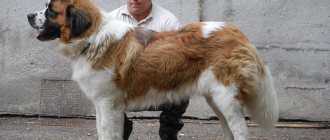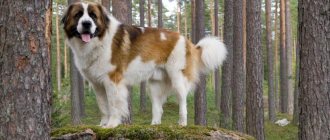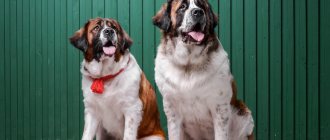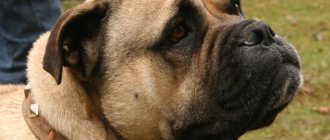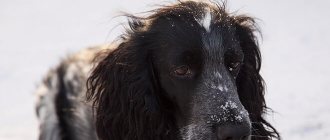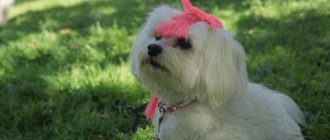Description of the history of the breed
This breed is one of those few, the creation and modification of which were carried out by the best biologists and breeders. This unusually strong and fast breed was bred specifically by order of government authorities. And while the history of other breeds is shrouded in mystery, the pedigree of Muscovites is open and transparent, and the fact that they were born for a special mission only adds prestige and charm to the breed.
After a war that not only claimed thousands of lives, but also left many dogs homeless and shelters destroyed. The workers of the Krasnaya Zvezda kennel, which was located in the Moscow region, were tasked with raising dog breeding from its knees. The letter that came “from above” clearly stated: “ To breed a breed for protection that would correspond to a high class of speed, endurance, physical strength and is easy to train .”
The basic breeding “ingredients” of the work were the St. Bernard and the Caucasian Shepherd - these two breeds, absolutely polar in character, gave birth to such an unusual combination. Also involved in the process:
- German Shepherd;
- Newfoundland;
- Russian greyhound;
- Russian piebald;
- Russian hound.
This was a very difficult job, because it is always more difficult to correct the results of multi-species crossing, but Russian cynologists coped with the task perfectly.
Not only the best and healthiest representatives of the breed were chosen for crossing, but also those who distinguished themselves during military operations and hostilities. The entire procedure was carried out in the fifties of the twentieth century. The entire process was supervised by A.P. Mazower, owner of the shelter. The firstborns of the breed were shown at an exhibition in Moscow, but at that time they were still listed in the documents as a “crossbreed”.
Subsequently, the breed was modified, and all changes were documented. The parents of purebred Moscow watchdogs were Ashi (Caucasian Shepherd) and Barry (St. Bernard). The government's order was carried out. The standards and basic traits of the breed were documented in 1958, although they have changed several times since then.
All subsequent work on breeding dogs and maintaining the breed population was carried out by amateurs on a voluntary basis. Most amateur dog breeders note that the breed has changed for the worse. Absolutely all breeds go through this process on their way to the ideal.
The history of the origin of the Moscow watchdog
In the middle of the 20th century, the country needed strong four-legged defenders. In a domestic kennel called “Red Star”, the leadership of the military dog breeding school received a state order to breed dogs with excellent guarding qualities and great endurance. Animals had to withstand harsh climatic conditions, long periods without food, and heavy physical exertion. The base of the nursery was poor in the variety of breeds. Mostly trophy specimens from Germany were kept there. But, despite this fact, Soviet breeders managed to develop four new breeds, including the Moscow Watchdog.
Matings were carried out with Russian piebald hounds, St. Bernards, and East European shepherd dogs. “Muscovites” adopted many character traits from Caucasian Shepherd Dogs. Their family also became involved in breeding the ideal four-legged fighter. The main goal of the breeders was to convey the natural aggression characteristic of Caucasian Shepherd Dogs.
In 1950, Moscow dogs took part in the exhibition for the first time. Joy, Despot, Divny, Don, Dukat and Dido are six littermates who managed to earn special attention from the jury, although they had some defects.
At the end of the 50s, an exterior standard was formed. The official recognition of the breed in the Soviet Union dates back to 1985. International cynological organizations to this day are dubious about “Muscovites”. They are usually found in the CIS countries, the Czech Republic, and Poland, where they are bred by individual breeders, but not by nurseries.
Characteristic
The Moscow Watchdog is a large specimen with a wide skeleton and massive muscles. The body is slightly elongated, the paws are long and large.
The dimensions are as follows: height at the withers for males - 68 cm, for females - 66 cm. The weight of males is from 60 kg and above, while females weigh from 45 kg.
- The neck is wide and short, with a slight overhang possible.
- The head is also large, the forehead is wide. The transition to the muzzle is clearly defined.
- The ears are drooping and triangular in shape. The eyes are round, dark, deep-set.
- The bite is oval, the teeth are large and sharp.
- The chest is wide, the back is straight, the height at the withers should ideally be slightly higher than the height at the rump.
- The front and hind legs are straight and isometrically fixed. The length of the forelimbs is equal to half the height at the withers. The paws are large and round.
- The tail is wide, located high, its length reaches the hock joint. The base is located in line with the croup; when active, it rises in the shape of a sickle above the line of the back.
- The coat is thick and shiny with a dense undercoat. On the head it is a little shorter, and males have manes, fox tails, and trousers, giving the dog even more aristocracy and volume.
- The color is light red or light red-brown. There are black markings on the face and ears. It is considered a good sign when the entire chest, collar, front legs along the entire length and hind legs up to the knee joint, the tip of the tail are white. Particular attention is paid to the color of the muzzle: black “glasses” should have a symmetrical shape and completely cover the eyes, and there should be a white mark in the center of the muzzle.
The Moscow Watchdog is more active than its ancestor, the St. Bernard, and moves at a shallow trot or a heavy gallop.
Photo
Adult
Photo with a person for clarity of size!
Puppy
basic information
| Breed name: | Moscow watchdog |
| Country of origin: | Russia |
| Time of origin of the breed: | XX century |
| Type: | 1 |
| Weight: | 45 – 60 kg |
| Height (height at withers): | 66 – 78 cm |
| Lifespan: | 10 – 13 years |
| ICF classification: | not recognized |
| Price of puppies: | 100 – 400 $ |
| The most popular nicknames: | list of nicknames for the Moscow watchdog |
Character
Sad and a little melancholy, Moscow watchdogs are loyal friends to their owners and his family members. These dogs are distinguished by increased endurance, lack of fear and determination in protecting the owner. The presence of such a dog will allow owners of private houses and those who live in the private sector to sleep peacefully.
Moscow watchdogs never “give back” in the face of difficulties; they are always aimed at protecting the territory. In addition, this dog gets along well with children and pets, which captivates many owners. These dogs are very smart and loyal, they are always on guard of their immediate environment.
It is worth noting that the Moscow watchdog is not a “barking” dog; barking is only given in cases of emergency , when there is an external threat. These dogs are easy to train and always obey, which makes them high-class “guardians.” The Moscow Watchdog loves an active lifestyle, but easily adapts to a calm rhythm, to the conditions of protecting the territory in a “quiet” mode.
With proper training and a competent approach, dogs of this breed become true friends of a person, leaving a significant mark on a person’s soul and memory. But you shouldn’t immediately leave them alone with small children without supervision; Moscow watchdogs can accidentally harm a child, simply because of their large size.
It is advisable to trust such a dog with the defense of land and private property, since keeping Moscow watchdogs in apartments is undesirable.
The character of dogs of this breed requires communication with a balanced, calm, kind person. The character of this breed can be briefly described as follows: “Less words - more action.”
Price: how much does a puppy cost?
There are many nurseries that offer interesting deals. Buying puppies from a nursery, of course, will cost much more, but you get a guarantee that you are purchasing a “Muscovite” and not a mixture of breeds. This puppy will carry the genes appropriate for the breed. Also, all puppies from the nursery are healthy and without developmental disorders.
On the market and through advertisements, it makes sense to buy puppies only to save money, but at the same time you need to be prepared to stumble upon a crossbreed. In such cases, it is advisable to look at the parents, but still, in the absence of documents, it will be difficult to make a claim to the seller.
The average price for a second hand purchase is 15,000 rubles. In nurseries - 20,000 rubles.
REFERENCE! Sometimes large nurseries hold promotions, selling purebred dogs at a lower price.
Is he afraid of shots?
The dog is not afraid of shots, which means it can be an assistant during the hunt, when guarding military enterprises, and noisy industries.
How long do they live?
Moscow watchdogs live relatively short, like most large dogs, from 8 to 10 years.
Reproduction and lifespan
Breeding large dogs is a difficult and very expensive task. Mating begins at 1.5-2 years, there are 6-7 puppies in the litter. Moscow Guard Dog puppies are weighty from a young age, and besides, it is not at all advisable to squeeze them. But this is not the main thing. You are responsible not only for the health of your mother, but also of future heroes.
They need to be shown to a veterinarian, vaccinated, fed, educated, and finally. Only professionals can handle such a respectable dog correctly from the first days, so that in the future there will be no deviations from upbringing. An ignorant owner can cause irreparable mental damage.
You need to be prepared for the fact that a large dog needs a large supply of food
And his viability in the profession will be under threat. The nursery will tell you not to adopt a gentle fluffy puppy, but a distrustful, suspicious puppy who does not immediately fit into your hands. He will then grow into a real service worker. Unfortunately, the life expectancy of the MS, like other large breeds, is short. On average 10-12 years.
Maintenance and care
Muscovites can live in either a small apartment or a spacious garden plot, but they like freedom and open spaces. It is worth noting that they quickly find a common language with people, obey them, but are always ready to fight enemies who encroach on the life and health of the owner.
A dog changes its “fur coat” twice a year, so it is so important to monitor the condition of its coat and comb it to avoid disease and hair loss. The most important thing is to introduce your pet to brushing from a young age, then there will be no problems with a lot of hair in the bed and on clothes, and the pet will always be combed and well-groomed.
It is important to remember that neglecting wool treatment threatens the formation of tangles, which will cause discomfort to the animal and pose a big problem for the dog’s owners.
Combed beauty!
Bathing should be done at least four times a year , but you can wash it more often if the coat is dirty. Moscow watchdogs love to swim in open waters, so the owner should not interfere with his pet’s play activities. Swimming in ponds, rivers and lakes well strengthens and distracts these huge dogs, which plays “in favor” of the owner.
The dog owner needs to monitor vaccinations (against gastroenteritis, distemper, rabies, leptospirosis). Be responsible about your health so as not to spend a lot of money on treatment. You also need to remember about prevention against worms and ticks.
The starter kit for the “Muscovite” includes:
- Set of bowls;
- Brush;
- Leash;
- Collar.
You also need to allocate enough personal territory for the animal in the apartment, where it will be comfortable and calm. But it is more correct to keep dogs of this breed in an open area, providing them with an enclosure and a booth with insulation. Muscovites tolerate heat and cold well, which elevates them to the class of “universal soldiers.”
Walking with a dog of this breed consists of 2-3 trips into the fresh air, lasting at least 60 minutes.
Walk
Representatives of the breed need long-term walking and physical exercise. The ideal place for a dog to live is a country house, where it will have free access to the territory.
If a representative of the breed lives in an apartment, then you need to walk him at least 2 times a day. The duration of the walk should be at least 1-2 hours.
If you need a dog that is ideal for keeping in an apartment, we recommend reading the article
It is not enough to just walk down the street with your dog on a harness . Walks should be active.
They should include jogging, elements of training and games such as agility . However, you should not overload the dog either.
The skeleton of a representative of the breed is in the process of growth and strengthening for up to a year. During this period, loads should be moderate
What to feed?
You need to feed your dog meat, mostly raw. Do not give long bones, because this dog more often than others swallows them whole, as a result of which it has problems with digestion. You will also need porridge with water, vegetables and, possibly, fish (if there are no allergies).
Accustom your dog to a certain diet and menu. Always feed at the same time, this will help develop the dog’s character and will also be convenient for you. The owner must provide food exclusively .
You can also use dry food, but keep in mind that it is expensive to provide the Moscow giant with the necessary amount of ready-made food per day.
Feeding the puppy
The puppy must be fed cottage cheese with kefir, beef, rice and buckwheat porridge with (preferably) goat milk . It is ideal if you take care of vitamin supplements for your puppy.
Remember : babies of any size are prone to stomach upsets, so introduce each new product into complementary foods gradually, with a break of 2-3 days.
Cerberus diet depending on age: what should you feed your puppy? The best porridge for a puppy: feed it tasty and healthy
The main health problems in this breed arise in the joint-ligamentous system and the hormonal system.
Allergic reactions and possible obesity in these dogs can be eliminated by the owner, but all measures should be carried out only under the supervision of a veterinarian. Like all mammals, dogs are susceptible to viral diseases, including pandemic ones, which once again proves the importance of vaccination and medical diagnosis
Nutrition
When living in an apartment, the Moscow Watchdog is more susceptible to obesity and allergies. For this reason, the owner must carefully monitor the pet’s diet.
This article will tell you more about allergies in dogs.
The dog owner can choose balanced dry food or natural food for it. When choosing the latter, your dog’s diet should include:
- Porridge;
- Vegetables;
- Lean meat.
Important! Don't forget about vitamins and nutritional supplements. They should also be present in the pet’s diet.
The Moscow watchdog should not be given:
- Meat with high fat content;
- Flour products;
- Small bones;
- Sausage;
- River fish.
A puppy's diet is different from that of an adult dog. Up to 7 months, the amount of food should be 20% of the animal’s weight. You can give your puppy:
- Dairy products;
- Hard cheese;
- Vegetables;
- Porridge;
- Bran.
Up to 7 months, the puppy should be fed 5-6 times a day.
It is enough to give food to an adult dog 2-3 times a day.
Important! When purchasing a dog, the new owner should ask the breeder about the type of feeding the puppy will receive. You should not suddenly change your diet. The change will negatively affect digestion.
If the owner gives the dog dry food, it should be from a trusted manufacturer. Poor quality nutrition will negatively affect your dog's health.
Training and education
The first step is to teach the dog order and discipline, because such a breed can even accidentally harm humans and other pets. The dog should follow simple basic commands (“Stop!”, “Get down!”, etc.) from the age of 2-3 months. The main feature of this breed is their long stay in the childhood period, which complicates the training and upbringing of the puppy.
However, with the right approach, Moscow watchdogs can quickly learn the necessary skills, which usually involve protecting the life and territory of the owner. If you lack patience and training skills, it is recommended to contact specialists.
Since dogs of this breed are very intelligent and active, they are quite easy to train. The most important thing for the Moscow watchdog is to delineate its specific location, because it will always protect its territory . Also, do not forget that you yourself must be strong in character and disposition and not give up your positions, as the dog will try to take a dominant place in his new pack. Do not be afraid of the dog or show fear under any circumstances - the dog may perceive this as a sign of weakness and will stop obeying and respecting you.
The dog is very active, so it is important to give it the right amount of physical activity, however, all attempts to bite the owner, even playfully, should be stopped. Do not intentionally develop aggression in the breed, because it cannot always be controlled.
How to train a dog is an individual matter, and the most important thing in this is to lay the right foundation . Try to find a middle ground between a loving and affectionate owner and a tough trainer. The dog must understand that you are its owner. But still, if you have any difficulties, problems, or want to teach your dog something specific, you can always turn to the services of a dog handler.
But you should remember that each dog also has its own character, do not break it if you do not want to raise a simple machine to protect the yard or house. After all, it is much better when the dog is not only a guard, but also a wonderful friend for the whole family.
Description and features
The Moscow Watchdog is often confused with the Caucasian Shepherd or St. Bernard. This is no wonder, because both of the above breeds are its progenitors. And the dog inherited many traits from them. However, there are noticeable differences. They differ in coat color from Caucasians, and from St. Bernards in their bone structure, muscles and weight.
If you see a large dog of red and white color, with dark tips of the ears and a mask on the face, especially black around the eyes, you know that this is a Moscow guard dog . She doesn’t look like a big, kind dog; on the contrary, she has an outstanding build, well-developed muscles, powerful paws, a confident gait, and an attentive look - all this characterizes a dog of special training.
A kind of special forces among dogs. The Moscow guard dog in the photo looks like a hero, especially against the background of other animals, objects or people. It is impossible to flirt with her, only negotiate. It seems that in her “dog vocabulary” there is only a set of commands. However, hidden within that big body is a noble heart.
Understanding his status perfectly, the dog never shows excessive aggression; it is difficult to start him off like a “Caucasian” ancestor. He fits in well with the family, loves children and reacts calmly to other animals. An obligatory aspect is education, and it should be dealt with by a professional mentor. Then your home and family will be under reliable protection.
Moscow guard dog is an intelligent and friendly breed of dog.
Health and illness
- The main weaknesses of this breed are considered to be diseases of the joint-ligamentous system and the hormonal system.
- Improper feeding and maintenance can cause allergies. Allergic reactions and possible obesity in these dogs can be eliminated by the owner, but all measures should be carried out only under the supervision of a veterinarian.
- Like all mammals, dogs are susceptible to viral diseases, including pandemic ones, which once again proves the importance of vaccination and medical diagnosis
Differences with St. Bernard
Are Moscow Watchdog and St. Bernard not the same thing?
Since these two breeds look very similar to each other, we hasten to dispel this myth - they are not the same breed. St. Bernard is the progenitor of the Moscow watchdog, therefore the external color and size are extremely similar.
What is the difference?
Saint Bernards are very massive by nature - the weight of these dogs can reach eighty kilograms, and their height can be up to seventy centimeters at the withers. Therefore, their closest relative is also considered a large breed. The height of the Moscow watchdog is also about 60-70 centimeters, but the dog itself is much narrower and drier in the body than its ancestor. Therefore, the usual weight for this breed is 45-50 kilograms.
Try to find the differences between the Moscow Watchdog and the St. Bernard in the photo comparison:
The St. Bernard's head is wider and larger, and only one specific type of color is allowed for this breed. However, if you look at it from the other side and pay attention to the tail, the Moscow watchdog’s tail is not capable of curling into a donut, more even than that of its ancestor.
The main external highlight of the St. Bernard has always been considered to be deep, seemingly sad eyes and large ears hanging right down to the end of the muzzle. His ancestor did not inherit such long ears - usually their length is limited to the zygomatic cavity, and there is no wide lower eyelid, creating the effect of “sad eyes”.
Saint Bernard
The most important and important difference between these two breeds is their character . Saint Bernard is a breed recognized all over the world, has an unusually calm and balanced disposition, is good-natured like a teddy bear and is able to come to a person’s aid, despite its impressive size.
The character of the Moscow watchdog differs significantly. A dog of this breed was bred specifically for protection, because it is more willful, can show rigidity in behavior and show aggression. In the absence of proper training, this breed can cause a lot of problems both for the owner and for the people around him. However, this does not mean that she is evil! No - this is an active but strong animal that needs to be taught to communicate!
Moscow watchdog
If you still compare the main traits of their characters, the St. Bernard is suitable for a family with children , he will not offend or bite members of his “pack,” and the Moscow watchdog should be taken to a house where a guard is really needed .
The similarity of these breeds is that they are very unpretentious and not capricious in their maintenance - both in feed and walking rules. The main problem of these two dogs can only be the presence of thick hair, which is not very easy to comb out and bring into proper shape every time they shed.
How to choose a dog
Moscow Guard puppies cannot leave anyone indifferent. They resemble bear cubs with sad eyes.
However, in order for the animal to please the owner for many years, the choice of puppy must be made with an open mind. The future owner should pay attention to:
- Breed standard. Before visiting a nursery or private breeder, you should familiarize yourself with the breed standards in advance. The chosen animal must correspond to them.
- Availability of documents. They must be present in the puppy. The documents confirm that the animal is purebred and will have all the breed qualities and appearance. The price of a representative of the breed will be higher, but this way the owner will protect himself from buying a mestizo.
- Appearance. The puppy must be well-fed, have a wet nose, clean ears and eyes. He must have a good appetite.
- Fur pigmentation. The presence of large white spots on the puppy's head and the absence of dark glasses may indicate a weakness of the nervous system.
- Contact. Kids who are good at communicating are suitable for owners looking for a pet to live with the family. Puppies will perceive the owner and his loved ones as members of the pack. If a dog is needed for protection, then you should choose a baby who is suspicious of new people.
- The character of the parents. You should not take puppies from a cowardly mother. Kids can inherit this quality from her.
Important! To get an idea of the future appearance of the puppy, you can ask the breeder for a photo of the male who is the father of the litter.
The price of a puppy depends on the availability of documents, achievements and qualities of the parents. It can range from 350 to 2500 dollars
Owner reviews
Tatyana writes: Our family always had dogs, but for some reason they were mostly Collie breeds. But after we saw this fluffy miracle, which shook its ears and joyfully ran towards us, there was no doubt left, we are taking this dog! So a new friend appeared in our family, who perfectly guards the house and does not allow strangers into the yard, always greets his owners, is very smart and quick-witted. In a word, not a breed - but a fairy tale! He’s been living with us for 10 years now, and we’ve never regretted buying him!
Maryana says: When my husband and I decided to move from an apartment to a private house, there was no doubt - there should be a dog in the yard. We didn’t understand all the intricacies of breeds, characters, feedings at all - we just thought about making a friend for the soul and not bothering ourselves. One day, in one of the advertisements, I came across photographs of fluffy balls and immediately fell in love - I took my husband with me and we went to look and choose. As soon as we saw their parents - tall and menacing handsome men with massive paws - we knew we had come to the right place. Since then, Ralph has lived with us - a huge dog who lives up to his breed as a Moscow watchdog - he guards the house and makes us happy.
Andrey shares: This breed is what I needed! I have always dreamed of a characterful, large dog that would be a joy to my soul. And so, when I bought it and began to work with it, I realized that the Moscow watchdog perfectly suited my character and lifestyle. Excellent training ability, requires physical activity. The only problem is the fur, you need to keep an eye on it, otherwise it will start to mat. And the breed is simply super. I recommend to everyone.
Complaints and possible problems with the breed
Elena: I never thought that giving a dog a bath would be such an adventure. And you will have to bathe her five or six times a year, because this shedding will simply drive you crazy. The coat needs care, and without proper attention, the dog will begin to smell, and after that, these lumps will only have to be cut off.
Dmitry: Well, I had a hard time with training! I took a dog from a kennel, they promised a pure breed, excellent character. As a result, my Milo at first did not understand at all what I wanted from him. When teaching the command “Place!” and completely growled, made a sad face and turned away. As soon as he was put on a chain, he gnawed everything he could reach. I solved this problem only with the help of a dog handler, because I thought that I myself could only make the situation worse. Therefore, keep in mind that all dogs, like people, are individuals. Be prepared for difficulties.
Victoria: I didn't have any particular complaints about this breed. However, as soon as summer arrived, and here it is hot, I realized that the Moscow watchdog tolerates the summer heat disgustingly. Our Lady could lie for days without even raising her head in the shadows - let alone protection. Every time she had to carry a bowl of water directly under her muzzle - she was too lazy to even get up to drink. That’s why I don’t even know if it’s my mistake in choosing the breed or if it’s just the dog’s character. I'm not very happy with this display of laziness. This breed has always seemed active and cheerful to me.
Some interesting facts
- There are cases in history when the owners of these dogs entrusted them with the care of small children. And it must be said that these animals coped with the task with all 5 points. Moscow watchmen are always on guard for threats, vigilantly monitoring the territory and people entrusted to them.
- Moscow watchmen are called upon to serve people, which they do just as well. Huge, somewhat clumsy-looking dogs always treat people with kindness. They feel the mood and will not pester the owner if he is busy or out of sorts.
- You have to try hard to raise such a dog to be sloppy or disobedient. Still, many years of history and genetic factors have laid down certain rules and disciplinary norms in the subcortex of each new individual.
- These dogs are often used for rescue operations, particularly by firefighters and coastal patrol.
Pros and cons of the breed
When you decide to have a pet in the form of a purebred dog, choose the type that suits you. If you have enough time to devote to your dog, if you have the willpower and the ability to keep a large animal, pay attention to the Moscow watchdog. The main pros and cons of representatives of the breed are outlined below.
Advantages:
1. Developed protective and security instincts. 2. Devotion, fearlessness. 3. Love for children. 4. Balance. 5. Pet Friendly. 6. Rarely barks. 7. Good health. 8. Ability to withstand severe frosts. 9. Can be kept in an enclosure.
Best nicknames
How to name a Russian dog:
For boys
- Captain Shrek
- Mr. Rachok
- Prapor
- Buffalo
- Vladimir
- Abu
- San Sanych
- Kamikazde
- Partisan
- Illidan
- Garrosh
- Thrall
- Wooljin
- Mut
- Zolic
- Shedar
- Saiden
- Charm
More than 100 boy dog names: choose with taste
For girls
- Silvana
- Alleria
- Sonya
- Bagheera
- Mandrake
- Lesya
- Titmouse
- Martin
- Baby
- Thumbelina
- Hermione
- Paprika
- Liquidation
- Storm
